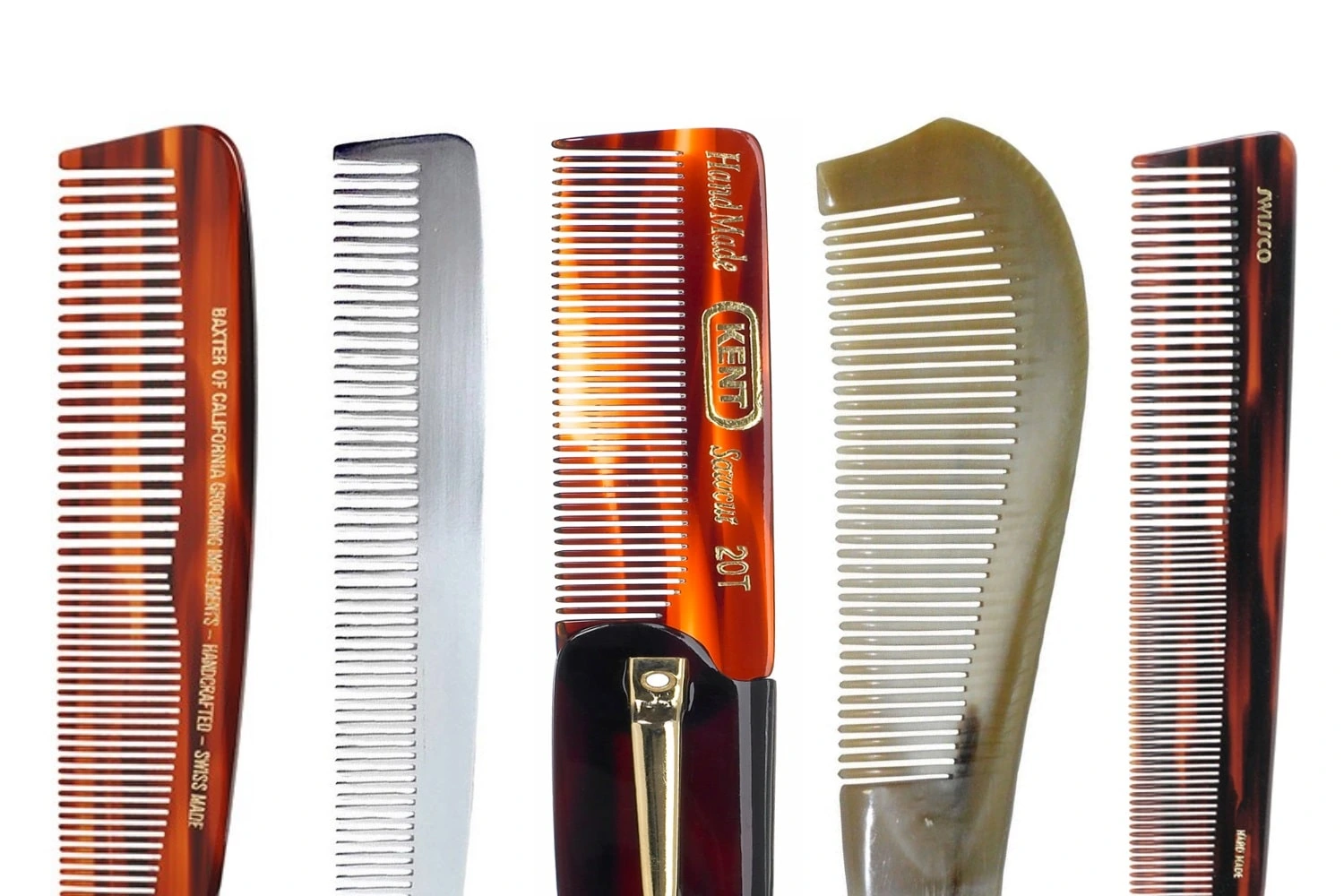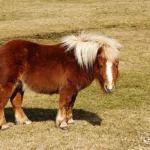
A comb is a common grooming tool used to untangle and style hair. Typically made from plastic, wood, or metal, combs come in various shapes and sizes, catering to different hair types and styling needs. They can help distribute natural oils, remove knots, and create smooth hairstyles. Combs are essential for personal grooming and can also be used in various professional settings, such as salons and barbershops.
Ancient Origins: Combs have a rich history, with the oldest known examples dating back to around 5,000 years ago in ancient Egypt. These early combs were often made from materials such as wood, ivory, or bone and were intricately designed, showcasing the craftsmanship of the time. They served not only practical purposes for grooming but also held cultural significance, often being found in burial sites, indicating their value in daily life and rituals.
Etymology: The term “comb” derives from the Old English word “camb,” which refers to a toothed instrument used for untangling and arranging hair. This linguistic root reflects the comb’s longstanding importance in personal grooming across various cultures and eras. The evolution of the word mirrors the comb’s transition from a simple tool to a widely recognized symbol of beauty and care in different societies.
Material Variety: Combs are crafted from diverse materials, including plastic, wood, metal, and bone, each offering unique benefits. Plastic combs are lightweight, durable, and often used in everyday settings due to their affordability. Wooden combs, on the other hand, are favored for their aesthetic appeal and the gentle way they treat hair, reducing static and frizz. Metal combs are typically used in barbershops for precise styling and cutting, while bone combs are prized for their historical significance and craftsmanship.
Standard Dimensions: The average width of a standard comb is about 2 inches (5 cm), a size that allows for easy handling and maneuverability while grooming hair. This dimension is designed to fit comfortably in the hand, providing sufficient control for users. The compact size makes it convenient to carry in bags or pockets, ensuring that individuals have access to this essential grooming tool whenever needed.
World Record for Length: The longest comb in the world measures an impressive 3.5 meters (11.5 feet) and was created in India. This record-breaking comb serves as a testament to human creativity and craftsmanship, showcasing how combs can transcend their practical use and become objects of art. Such large-scale combs are often used in promotional events or exhibitions, highlighting the cultural significance of grooming tools in various societies.
Grooming Versatility: While combs are primarily associated with hair grooming, they also play a vital role in styling beards and mustaches. The design of combs allows for different grooming techniques, such as shaping or untangling facial hair. This versatility makes combs essential tools for barbers and individuals alike, as they can be used to achieve various styles and maintain facial hair with precision.
Detangling Efficiency: The fine-toothed comb is particularly effective for detangling hair, especially for those with longer or thicker hair types. The closely spaced teeth glide through knots and tangles, minimizing breakage and damage. This type of comb is often recommended for use on wet hair, as it can help distribute conditioner evenly while reducing the risk of pulling and tearing the hair shaft.
Types of Combs: Combs can be classified into two main types: wide-toothed and fine-toothed. Wide-toothed combs are ideal for detangling wet hair and are often used in conjunction with styling products. Fine-toothed combs, however, are better suited for creating precise hairstyles, parting hair, and smoothing out flyaways. Understanding the differences between these types allows users to select the right tool for their specific hair care needs.
Largest Collection: The world’s largest comb collection is owned by a private collector in the United States, boasting over 3,000 unique combs. This extensive collection reflects the cultural and historical significance of combs across different eras and regions. Collectors often seek out rare and antique combs, which can provide insight into the styles and grooming practices of past civilizations, making combs not just functional items but also valuable pieces of history.
Cultural Significance in Japan: In Japan, traditional combs known as “kogai” are often used in hairstyling for geishas, symbolizing beauty and elegance. These combs are intricately designed and can be made from materials like lacquered wood or metal, often adorned with decorative motifs. The use of kogai in traditional Japanese hairstyles highlights the comb’s role in cultural practices and the importance of grooming tools in maintaining cultural identity and heritage.
Frequency of Use: The average person uses a comb or brush approximately 1,000 times a year. This frequency highlights the significance of combs in daily grooming routines, as they help maintain hair health and style. Regular use of a comb can aid in distributing natural oils from the scalp throughout the hair, promoting shine and reducing dryness. This routine underscores the comb’s role in personal care and hygiene.
Arts and Crafts Utility: Combs can be creatively repurposed in arts and crafts, particularly in painting and design. Artists often use the teeth of a comb to create textured patterns in paint, producing unique effects on canvas or paper. This innovative use of a commonplace item demonstrates how combs can transcend their original function, inspiring creativity and artistic expression in various forms.
Guinness World Record: The Guinness World Record for the largest comb was set in 2010, measuring an astonishing 7.5 meters (24.6 feet) long. This record highlights not only the ingenuity behind creating such a large object but also the playful spirit that surrounds everyday items like combs. Such large-scale combs are often showcased at events or in exhibitions, capturing attention and emphasizing the cultural significance of grooming tools.
Oil Distribution: Combs play a crucial role in hair health by helping to distribute natural oils from the scalp through the hair strands. This process enhances the hair’s natural shine and helps prevent dryness and brittleness. Regular combing can also stimulate blood circulation in the scalp, promoting healthy hair growth. This functionality emphasizes the importance of incorporating combing into daily grooming practices for maintaining hair vitality.
Handle Design: Many combs feature a handle design that enhances grip and control during use. This ergonomic feature allows for easier maneuverability, especially when styling or detangling hair. A well-designed handle can significantly improve the user experience, making it more comfortable and efficient to achieve desired hairstyles. The design of combs has evolved to meet the needs of various users, from everyday individuals to professional hairstylists.
Cultural Gift Symbolism: In various cultures, combs are considered symbols of beauty and are often given as gifts. This tradition underscores the comb’s significance beyond mere functionality, representing care and thoughtfulness in personal grooming. Gifting a comb can convey wishes for beauty and well-being, making it a meaningful present during special occasions, such as birthdays or weddings.
Plastic Popularity: Plastic combs gained popularity in the 20th century due to their affordability, durability, and ease of production. The introduction of plastic revolutionized the comb industry, making grooming tools accessible to a broader audience. Plastic combs are lightweight and resistant to moisture, making them ideal for everyday use. Their versatility has led to a wide variety of designs and colors, catering to diverse consumer preferences.
Lifespan of Plastic Combs: The average lifespan of a plastic comb is around 5-10 years with proper care. Factors such as exposure to heat, moisture, and physical stress can impact the durability of a comb. Regular cleaning and proper storage can help extend its life, ensuring that users can rely on their combs for years. This longevity reflects the quality of materials used in manufacturing and the importance of maintenance in prolonging the usability of grooming tools.
Lice Removal Tool: Combs, particularly fine-toothed ones, are effective tools for removing lice and nits from hair. The closely spaced teeth can catch and extract these pests, making them an essential part of treatment for head lice infestations. Many parents and caregivers keep specialized lice combs on hand as a preventive measure or treatment option, highlighting the comb’s practical application in maintaining hair health and hygiene.
Mass Production History: The first mass-produced combs were made in the early 1900s using celluloid, an early form of plastic. This innovation marked a significant shift in the comb industry, allowing for the widespread availability of affordable grooming tools. Celluloid combs were lightweight, colorful, and could be produced in various shapes and sizes, paving the way for the modern comb market. This transition reflects advancements in manufacturing and material science, which have continued to evolve over the years.
First Aid Utility: Combs are often included in first aid kits for their utility in hair management. In emergency situations, a comb can be used to quickly and effectively manage hair, ensuring that it does not obstruct medical procedures or visibility. Additionally, combs can help in assessing scalp injuries or conditions, making them a practical tool for caregivers and first responders. Their lightweight and compact nature makes them easy to carry in emergency supplies.
Barbershop Essential: Combs are indispensable tools in many barbershops and salons, where they are used for cutting, styling, and grooming hair. Barbers and hairstylists rely on various types of combs to achieve precision in their work, whether it’s for creating sharp lines, blending hair, or adding texture. The combination of skill and the right comb can significantly impact the final hairstyle, making it essential for professionals to have a selection of combs tailored to different techniques and hair types.
Musical Instrument Creation: Combs can also be used in the creation of certain musical instruments, such as comb harmonicas. This unique application showcases the versatility of combs beyond their traditional use in grooming. By placing a piece of wax paper or similar material over the teeth of a comb and blowing air through it, musicians can produce a distinctive sound. This playful use of a comb highlights its potential in creative and artistic expressions, bridging the gap between everyday objects and musical innovation.
Average Cost: The average cost of a standard comb ranges from $1 to $10, depending on the material and design. This affordability makes combs accessible to a wide audience, allowing individuals to choose from basic plastic options to more luxurious wooden or metal varieties. The price range reflects the diversity in quality and craftsmanship, catering to different consumer preferences and budgets. This economic accessibility contributes to the comb’s status as a staple grooming tool in households worldwide.
Historical Value: Combs are sometimes used in scientific studies to understand hair growth and health in various species. Researchers may analyze the structure and composition of combs found in archaeological sites to gain insights into the grooming habits and cultural practices of ancient civilizations. This research highlights the comb’s role not just as a functional item but also as a valuable artifact that can provide information about social norms, beauty standards, and daily life in different historical contexts.
FAQs About Combs
General Questions
1. What is the best material for a comb?
The best material for a comb depends on your hair type and personal preference. Here’s a breakdown:
- Plastic: Affordable, lightweight, and often durable. However, it can cause static and may not be suitable for all hair types.
- Wood: Eco-friendly, hypoallergenic, and can help reduce static. Popular choices include sandalwood, ebony, and beech.
- Metal: Can be durable and heat-resistant, but may be too harsh for certain hair types. Stainless steel and titanium are common options.
- Horn: Natural material known for its smoothness and ability to reduce static. Can be expensive and may require special care.
2. How often should I clean my comb?
You should clean your comb regularly to remove dirt, oil, and product buildup. A good rule of thumb is to clean it once a week. For combs used on hair with a lot of product or styling aids, you may need to clean them more frequently.
3. How do I clean my comb?
To clean your comb, use a mild shampoo or soap and warm water. Gently scrub the teeth of the comb with a toothbrush or comb cleaner. Rinse thoroughly and allow it to air dry.
4. What is the difference between a comb and a brush?
Combs have teeth that are spaced apart, while brushes have bristles that are closer together. Combs are generally better for detangling hair, while brushes are better for styling and adding volume.
Hair Type-Specific Questions
1. What type of comb is best for curly hair?
Wide-tooth combs are ideal for curly hair as they help detangle without causing breakage. Look for combs with rounded teeth to minimize damage.
2. What type of comb is best for fine hair?
Fine-tooth combs are suitable for fine hair as they can help add volume and control frizz. However, be gentle to avoid breakage.
3. What type of comb is best for thick hair?
Wide-tooth combs are also good for thick hair as they can help detangle and prevent breakage. Look for combs with strong teeth to handle the thicker strands.
Styling Questions
1. How do I use a comb to style my hair?
You can use a comb to style your hair in various ways, including:
- Detangling: Gently comb through your hair starting from the ends and working your way up to the roots.
- Styling: Use a comb to create specific hairstyles, such as parting your hair, creating waves, or applying styling products.
- Blow-drying: Use a comb to direct the airflow from your blow dryer, helping to achieve desired styles.
2. Can I use a comb on wet hair?
Yes, you can use a comb on wet hair, but it’s important to be gentle to avoid breakage. Use a wide-tooth comb and detangle slowly.
3. What is a rattail comb used for?
A rattail comb is a fine-tooth comb with a long, pointed handle. It’s commonly used for creating partings, backcombing, and applying hair color.
4. What is a pick comb used for?
A pick comb has wide, spaced-out teeth with a pointed end. It’s used for detangling curly hair and creating volume and texture.









